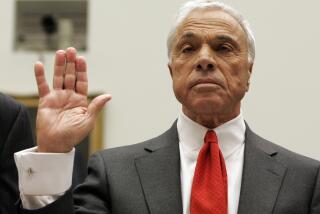COMMERCIAL REAL ESTATE : Tough Times in the Commercial Mortgage Market
- Share via
Investors looking for property loans from the commercial mortgage-backed securities market are facing a quick run-up in interest rates that comes almost exactly a year after a similar spurt occurred during the so-called “meltdown” of the CMBS market. That collapse killed countless real estate deals for lack of financing, drove some of the biggest CMBS lenders out of business, and left such a sour taste with borrowers that many remain skittish today.
Interest rates for CMBS loans on office and industrial buildings, apartment complexes and other commercial properties have climbed a full percentage point in the last two months to reach 8.5%, about the same level they reached at the depths of last year’s CMBS crash.
The higher rates still compare favorably with historic rates for commercial property loans, but they come at a bad time for a CMBS market still recovering from last year’s problems.
And while this year’s interest rate spike is the result of a temporary bond glut rather than a global financial crisis like it was in 1998, observers say, the effect on borrowers is similar enough to scare a lot of people.
“It looks like a meltdown because interest rates have gone up so much, but it isn’t,” said George Smith, a Century City-based mortgage broker. “If a borrower had a loan that he thought he was going to do at 7.25% and now it’s going to be at 8.25%, he feels like he’s seeing a meltdown.”
The current trend “could be the start of a long-term, upward shift in the cost of capital,” said Brian Foster, Los Angeles regional manager for New York-based Parallel Capital, a CMBS lender.
“I think a lot of borrowers are going to be in for a rude awakening if they expect rates to come back down to the 7% range,” Foster said.
But he said that the long-term outlook for the CMBS market is still sound, even though CMBS lenders are still repairing damage to their image that occurred when many of them reneged on loan commitments last year.
“We were just regaining some confidence from borrowers and then this hits us,” Foster lamented.
Commercial mortgage-backed securities are basically bonds created from pools of mortgages on commercial properties. CMBS loans have grown from about 5% of all U.S. commercial mortgages in 1994 to more than 16% of the $1.3 trillion held in commercial mortgages today, surpassing insurance companies as the No. 2 source of commercial property loans behind banks.
CMBS lending accounted for about half of the estimated $136.3 billion in total commercial real estate lending in the United States in 1998, according to a Donaldson, Lufkin & Jenrette analysis of Federal Reserve data.
Thus, when the CMBS market collapsed last year, it abruptly cut the flow of commercial real estate capital.
This year, “There is still tons of capital available; it’s just that the capital is costing more and is very particular about where it’s going to go,” said Tom Whitesell, a senior vice president at the Santa Monica office of Anaheim Hills-based Fremont Investment & Loan, an industrial thrift and loan.
CMBS lending in 1999 is providing less of that capital--about 25% compared with last year’s 50% of all commercial real estate lending, Foster estimated.
“The insurance companies have taken back a bigger piece of the pie, and the banks have too,” Foster said.
CMBS experts say this year’s interest rate spike resulted from a glut of bonds as U.S. companies rush to complete debt issues now to avoid the possibility of year-end computer problems.
With so many competing bonds on the market, CMBS issuers must pay higher yields to attract buyers. To pay those higher yields, CMBS lenders must charge higher interest rates to borrowers.
Among those who got caught in the CMBS credit crunch last year was Brad Mindlin of Mindlin Real Estate Group in Sherman Oaks, which invests in commercial buildings throughout the United States. The interest rate on one of Mindlin’s pending CMBS loans jumped by about 1.1% during the meltdown.
Mindlin got the loan eventually, after some harrowing negotiations with the lender, and he is still borrowing from CMBS lenders. But he also borrows now from insurance companies, which he says have become more competitive versus CMBS lenders.
The reduced market share for CMBS lending this year may be a desirable market correction, said Los Angeles attorney Adam Weissburg of Cox, Castle & Nicholson, who specializes in real estate finance.
CMBS loans became so popular, and the lenders so aggressive, that they “tried to be everything to everyone,” Weissburg said.
“It seems that the [CMBS] market is becoming more mature and more cautious,” Weissburg said. “In addition, other sources of lending are filling the gap.”
Borrowers should not ask themselves “should I get a CMBS loan?” so much as “what type of loan best fits the property?” Weissburg said.
CMBS loans have some drawbacks, he said. Paying them off early generally invokes severe penalties. And it’s extremely difficult for a CMBS borrower to negotiate any changes in loan terms once a mortgage pool is sold and the CMBS bonds issued. Portfolio lenders, by contrast, are usually more flexible.
Portfolio lender Fremont Investment & Loan is on track to lend $1.7 billion this year, compared with $1 billion in 1998, according to Whitesell. He said $475 million of last year’s total was lent in Southern California, where this year the company has lent $300 million thus far.
But Whitesell isn’t sure if commercial property lending can continue to grow at the rates of the last few years. The total of all U.S. commercial real estate lending grew from about $1.2 billion in 1994, at the depth of the recession, to more than $136 billion in 1998, according to the Donaldson, Lufkin & Jenrette study.
“If we’re at the peak of the real estate cycle, which many people argue that we are, maybe there will be a leveling off of all borrowing,” Whitesell said.
CMBS lenders will probably retain their fair share of the lending pie, Foster and others said, because these loans appear to be here to stay. Even with the gyrations in today’s markets, they say, it appears CMBS lending will avoid the fate of the lending source it replaced--savings and loans.
(BEGIN TEXT OF INFOBOX / INFOGRAPHIC)
Building Momentum
Banks still hold the largest portion of the approximately $1.3 trillion in commercial property mortgages in the United States, but commercial mortgage- backed securities have moved past insurance companies in recent years to take the No. 2 spot. The chart shows how much of U.S. commercial mortgages have been held by banks, savings and loans, insurance companies and commercial mortgage- backed securities from 1994 through year-to-date 1999.
Dollar value of U.S. commercial mortgage holdings by top four lending sources, in billions
Banks: $524.3
CMBS: $218.2
Insurance companies: $199.1
Savings institutions: $111.8
Sources: Donaldson, Lufkin & Jenrette: Federal Reserve
More to Read
Inside the business of entertainment
The Wide Shot brings you news, analysis and insights on everything from streaming wars to production — and what it all means for the future.
You may occasionally receive promotional content from the Los Angeles Times.










